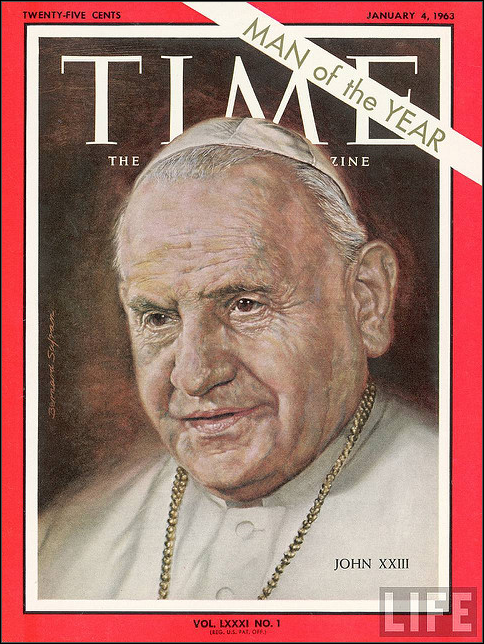Angelo Giuseppe Roncalli was born into a peasant family on November 25, 1881 in Sotto il Monte, Italy. From these modest beginnings, Angelo’s path would take him to Sainthood! However, the man who became the ‘Good Pope’ remained humble, simple and open to others throughout his life.
Angelo Giuseppe Roncalli
A Life in Service of Others: His Involvements
Man of the Church
Young Angelo showed an interest in religious life at an early age. He entered the Bergamo Seminary on November 7, 1892 and was ordained a priest on August 10, 1904. Because of his duties and dedication to the Church and his superiors, he was appointed Bishop (March 19, 1925), Cardinal (June 12, 1953) and Patriarch of Venice (June 15, 1953).
Educator
He began teaching at the Seminary in 1906. He taught the History of the Church, Patristics, and Fundamental Theology until 1914. In 1919, he became the Spiritual Director of the Bergamo Seminary. He entered service at the Holy See two years later.
Sergeant
During World War I, Angelo Roncalli served as a Sergeant in the medical corps and Military Chaplain in the hospitals of Bergamo. He took care of soldiers with tuberculosis at the risk of his own life.
Diplomat
Named Bishop in 1925, Monsignor Roncalli began his work as a diplomat in Bulgaria, Turkey, Greece and France that same year. During this period, which lasted until 1953, he made contacts and resolved conflicts outside the Christian community with simplicity, tact and humanity.
JOHN XXIII
A Man of Change: His Legacy
A Transitional Phase
Upon his return from Paris, Apostolic Nuncio Angelo Giuseppe Roncalli was named Cardinal by Pope Paul XII on January 12, 1953. A few days later, on January 15, he was appointed Patriarch of Venice. This new position gave him the opportunity to revive his pastoral work and visit parishes, hospitals and prisons to meet with the faithful.
Pontificate
Cardinal Roncalli was elected Pope on October 28, 1958 at the age of 77. Because of his age, he was considered to be a ‘transition pope’. However, Pope John XXIII left his mark on the history of the Church by calling the Second Vatican Ecumenical Council. The Council brought Church teachings, discipline and organization into the modern world. During his opening address, he said “I want to throw open the windows of the Church so that we can see out and the people can see in.” Sadly, he did not see the Council to completion. He died as a result of illness on June 3, 1963.
The Council’s Decrees
His successor, Paul VI, closed the Second Vatican Council in December 1965 with nine decrees, including Ad Gentes, a decree on the Church’s missionary activity. This decree marked a turning point for missionary work, asking missionaries to live with the people they are trying to convert and absorb their culture, hence the term ‘enculturation’. Many answered this call for openness towards others by entering the faith or travelling to mission countries.
Beatification and Canonisation
John XXIII was beatified on September 3, 2000 by John Paul II and canonised on April 27, 2014 by Pope Francis. His feast day is celebrated on October 11, the day the Second Vatican Council was opened.
How he is remembered
Icon
In his pursuit of his mission, John XXIII represents the essence of the Foundation. Indeed, the Sisters of Providence have been profoundly influenced by his care for the poor and his love and compassion towards marginalized people, regardless of race, social condition, religion or gender. This is why they have named their charity the International Roncalli Foundation.
Forerunner
Written in 1963, his encyclical Pacem in terris on establishing universal peace remains relevant today!
Pacifist
On May 10, 1963, John XXIII received the Balzan prize for his engagement for peace in the publication of his encyclicals Mater et Magistra (1961) and Pacem in Terris (1963) and his decisive contribution to peace during the Cuban Missile Crisis (1962).
First Permanent Observer of the Holy See at UNESCO
“The Permanent Observer of the Holy See to UNESCO explains his mission as providing a Christian presence, directly linked to the Authority of the Church, that serves to emphasize the importance of human beings in their complexity and uniqueness in the promotion of education, science and culture, which UNESCO's Constitution designates as instruments for peace and progress.”
More information, here!
Personality
- His virtues: humility, simplicity, humour
- His motto: “Obedience and Peace”
- His strength: diplomacy
 His career in diplomacy served him particularly well when he acted as mediator between President Kennedy (USA) and President Khrushchev (USSR) during the Cuban Missile Crisis, earning him the January 1963 cover of Time Magazine as Man of the Year!
His career in diplomacy served him particularly well when he acted as mediator between President Kennedy (USA) and President Khrushchev (USSR) during the Cuban Missile Crisis, earning him the January 1963 cover of Time Magazine as Man of the Year!